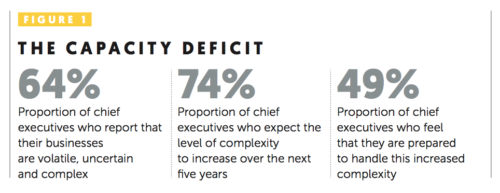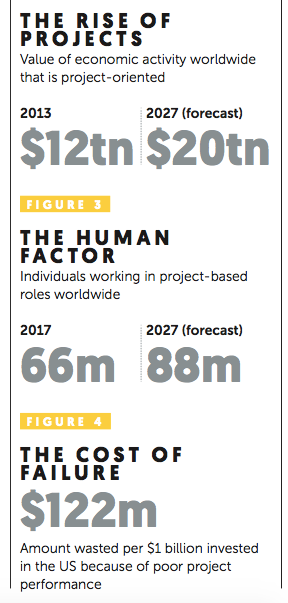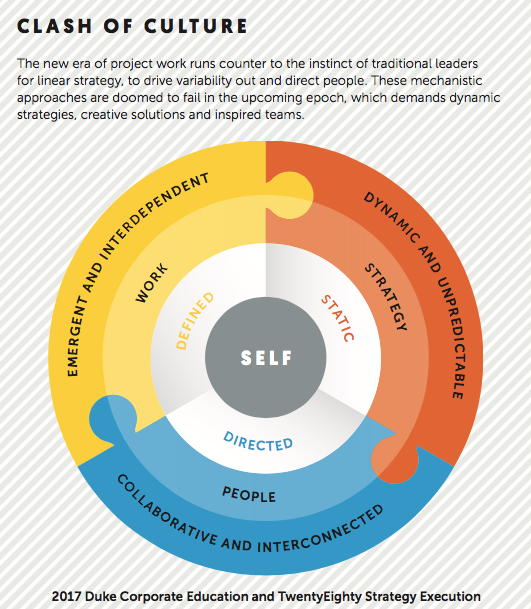Project-based work is the new normal. Leaders can either get on board or risk falling behind in this new operating environment.

Every industry on the planet is encountering unprecedented disruption thanks to new technologies, unforeseen forms of competition, and ever-increasing globalization. This dynamism makes the future less predictable while also rendering speed and agility much more important. “The dominant idea behind strategy – establishing a sustainable source of competitive advantage – is becoming irrelevant,” says strategy guru Rita McGrath.
Organizations need a new playbook to seize opportunities faster and develop their ability to adapt in real-time. This requires faster cycles between strategy formulation and execution, while learning how to stay closer to customers, innovate more rapidly, and adapt products and services. As leadership expert Peter Bregman said in his recent Harvard Business Review article, in today’s operating environment “your organization’s biggest strategic challenge isn’t strategic thinking, it’s strategic acting”.

A less discussed consequence of this new operating environment is the exponential growth in project-based work. About a fifth of the world’s economic activity a year – $12 trillion – is now organized as projects. Over the next decade, organizations are expected to experience a 68% increase in project-based work. As Duke CE educator and Dialogueauthor Antonio Nieto-Rodriguez notes: “This is one disruption affecting our world that media and academia have missed.”
Most of today’s organizations were designed to accommodate activity within functional or geographic silos. And coordination among people, budgets and work systems was accomplished as required. Project work was the notable exception, not the standard. Today, the volume and strategic importance of project work is on the rise, and being on – or leading – one or more projects is the norm.
Chief executives recognize that projects are the lifeline of strategy. In 2017, corporate heads classified more than half of their projects as strategic initiatives. This makes sense when you are leading in a world described by one auto industry executive as “two speed”. In his view, leaders need to “stabilize the current business and keep our promises to Wall Street, while completely transforming ourselves”. In this environment, it’s not surprising that a great deal of day-to-day baseline work still occurs in functions, while a growing portion of the important work related to executing strategy and transforming organizations takes the shape of projects. As Nieto-Rodriguez points out: “These projects cut across silos, set people to work towards a common goal, and align the organization to deliver change that creates value.” While chief executives acknowledge that executing projects faster and better is essential to win, they also worry that their own organizations are not prepared to do so. Their concern is well founded as research indicates that, in the last three years, 44% of strategic projects failed to be implemented.
So what’s behind this execution deficiency? Most testimonies suggest it stems from the inability to manage the complexity and change inherent in the operating environment. Important projects are designed as catalysts of change. These projects tend to cut across more boundaries, affect multiple stakeholders, have a greater number of external dependencies, and carry a sense of strategic importance and urgency.
As such, they also often involve a cross-boundary team from multiple disciplines and locations, who work in a distributed way.
The traditional theory of leading projects centred on time, cost and quality. It involved active and visible management of plans, money and people in what was assumed to be a relatively stable context. Given today’s inherent volatility and complexity, a more holistic and adaptive approach to managing projects is required. Meeting time, cost and quality goals in this disruptive context requires us to shift how we manage strategy, work and people – as depicted in Strategy Execution’s Leadership Framework (SELF).

Challenges with execution
Only 62% of strategic initiatives today have a clear link between objectives and strategy. And a whopping 41% of projects fail due to changes in strategy. The plan often calls for a linear progression. Yet the strategic reality demands adaptation to unexpected, disruptive events. Managers now spend more than 25% of their time on unanticipated work. So, good plans are essential, but the ability to adapt and manage change is increasingly becoming the real work, not the exception. Yet some 45% of chief executives say the leading barrier to successful project implementation is lack of change-management skills. As an executive said to me recently: “I know the world is more complex, but we need our organization to go faster and make work simpler.” Preparing people to lean into the complexity – and simplify it for others by knowing how to focus on what matters most – is critical.
The importance of leadership
In companies that manage highly successful projects, 81% report that leadership is the most important skill. One of the key reasons cited for projects becoming more complex to manage is having multiple, diverse stakeholders. Today, projects cross more boundaries, internally and externally, making the ability to connect, collaborate and influence a diverse set of stakeholders critical to success.
While diverse perspective can contribute to unique insights, the number and diversity of stakeholders often impedes decision-making. “Some decisions we have to make are hard, and the right answer doesn’t align with my functional goals,” said one project team member I interviewed recently, “so we tend to debate, push it back and schedule another meeting. But meetings create more process, not solutions.” Knowing how to own the issue, and influence the right people to act swiftly, is part of simplifying the complexity.
The partnership between Duke Corporate Education and TwentyEighty Strategy Execution has given rise to the Adaptive Strategic Execution Program, which is centred on shifting the mindset – and building the skillset – of professionals to better manage projects in a more complex world.
The project revolution is underway and the timing is right for chief executives to shift their frame and focus more on project leadership as a key to execution. They do this by asking a few simple questions:
- Are we doing all we can to set up our initiatives and projects for success?
- Are we equipping our people correctly to succeed and execute the strategy in this new environment?
- Do our professionals have the adaptive mindset and skillset required to ensure projects succeed today?
Shift your frame and ask some new questions. The future of your company depends on it.
An adapted version of this article appeared on the Dialogue Review website.




